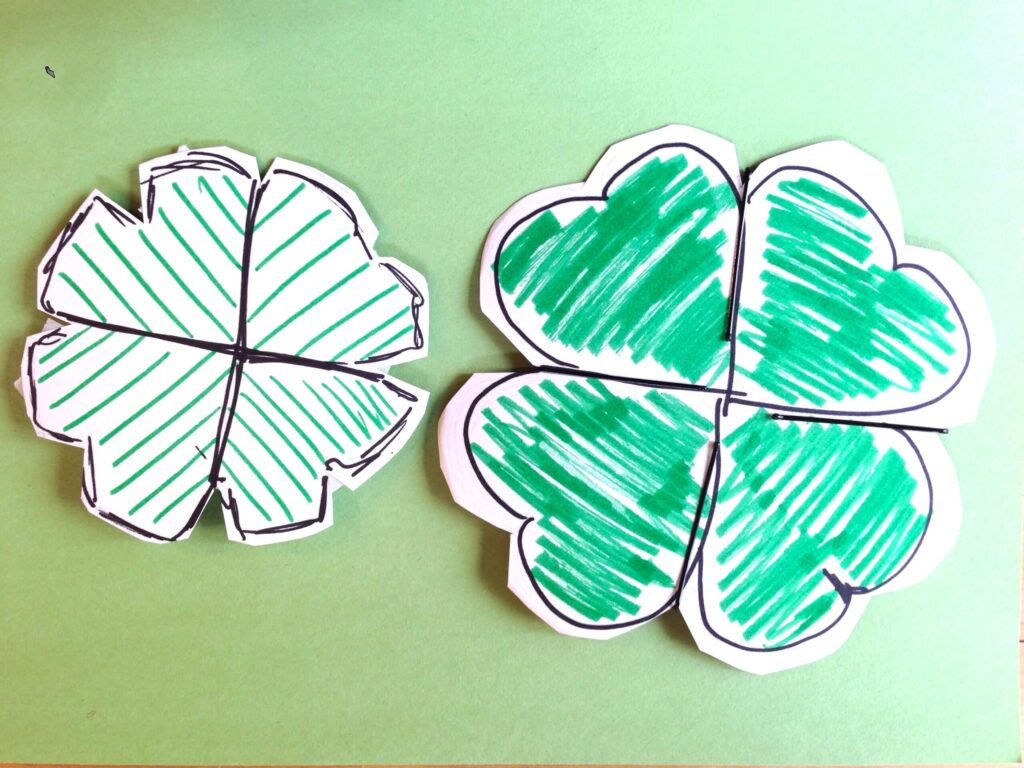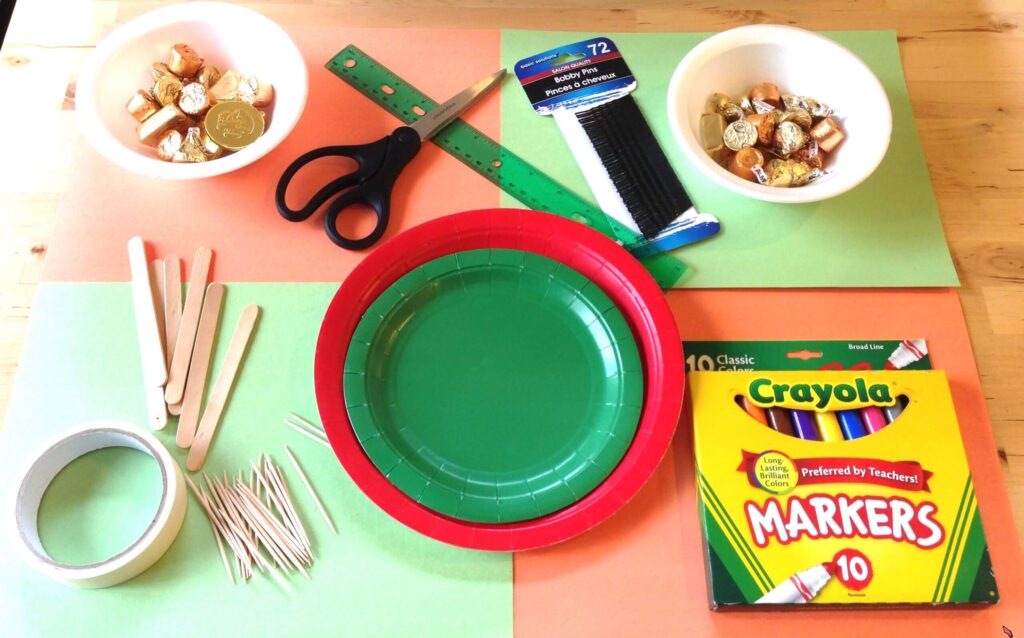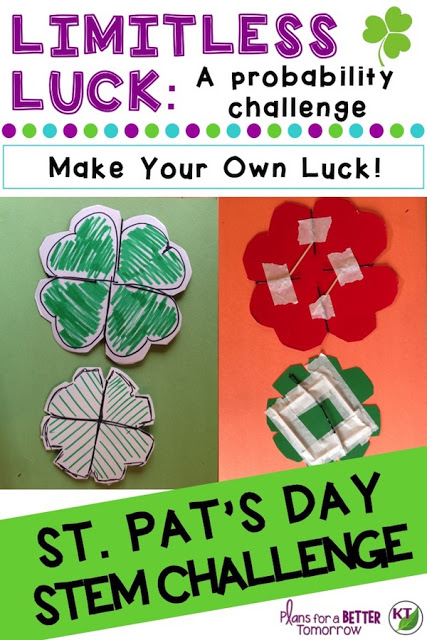It’s fun to think about symbols of luck: heads-up pennies, four-leaf clovers, and horseshoes, but making your own luck is so much more empowering! This St. Patrick’s Day STEM Challenge is all about probability!
Premise of Probability STEM Challenge: Limitless Luck
Working against a criteria & constraints list, students create a four-leaf frisbee designed to always land face-up! Your students will love exploring the concept of probability with this fun probability STEM Challenge! A horseshoe-like game is also included as an optional extension activity.


Materials for Probability STEM Challenge: Limitless Luck
This is a great last-minute probability STEM activity because you can get by with very few materials. The recommended set is shown in the embedded video below, but you can get by with some paper plates or card stock along with tape and some toothpicks, craft sticks, bobby pins, or pipe cleaners. As always, the materials are easily modified. You likely have what you need on-hand to support your students in exploring the concept of probability!
Note: The links below are Amazon Affiliate links. Find out more on the disclosure page.
- Pot of Gold game marker handout (included in resource) (1)
- Alternative: Use pots of “gold” (Gold chocolate coins, Almond Hershey’s Kisses or Rolos
- Paper plates (2 – 4)
- Bobby pins and/or paperclips (8 – 12)
- Tape (12 – 24 in.)
- Craft sticks (5 – 10)
- Toothpicks (10 – 20)
- Coin (any coin with heads and tails – 1)
- Markers/crayons
- Ruler
- Scissors
- Data recording & design analysis handouts (included in resource)
Optional
- Pipe cleaners (1-2)
- Straws (3 – 5)
- Index cards (5 – 10)

Video Walk-through of Probability STEM Challenge: Limitless Luck
Rather than write it all down for you to read, wouldn’t it be nicer to just sit back and watch? I’ve found creating video walk-throughs of my STEM challenges is the best/fastest way to explain the important details: materials, set-up, tips, modifications, extensions, and more! Check out the video below to learn more about the Probability STEM Challenge, Limitless Luck. However, if you prefer to read, you’ll find the video transcribed at the end of this post.
Are There Other St. Patrick’s Day Activities & STEM Challenges Like This?
Of course! I can’t help myself! You’ll find all five of the St. Patrick’s Day activity STEM challenges I’ve created in the 5-challenge bundle briefly described in this post. Each challenge post is linked there for the walk-through videos and more details. You can also find this St. Patrick’s Day activity and Probability STEM Challenge, Limitless Luck, alone (top left) or in a bundle of 5 St. Patrick’s Day STEM activities (top right). You may also like the Planetopia Project STEM Challenge Bundle & the Spring & Easter STEM Challenge Bundle. Please reach out with any questions and tag me in photos of your students’ work on Facebook & Instagram!
Related Posts
Video Transcription of Probability STEM Challenge: Limitless Luck
Hi there. Welcome to our final St. Patrick’s Day STEM Challenge, Limitless Luck, a.k.a. Four-Leaf Frisbee. In this one we’ll be exploring some of the symbols of luck, heads-up pennies, four-leaf clovers, and horseshoes, but the students are going to be trying to make their own luck. Before I get ahead of myself, let’s check out the materials in the STEM Challenge Cycle. This is the STEM Challenge Cycle you should follow for every challenge. I’ve defined each step in another video. I’ve added a pop-in card to that video here, as well as, a link in the description.
So this one you definitely want to have the students work with partners as opposed to groups. They’re going to be designing four-leaf frisbees that are designed to always land heads up for good luck. Okay, spoiler alert, if you haven’t already guessed, this Probability STEM Challenge is all about probability, but there’s also an optional game just for fun, that’s very much like horseshoes, but I’ll get to that when I talk about how to extend.
In the criteria and constraints, the students must design frisbees that have four distinct leaves. Each student will make his or her own frisbee, although it can match the partner’s design if they choose to do so, and the main goal of this challenge is that when the frisbee is tossed or flipped, that it will always land heads up. Now, of course, that’s not entirely realistic, so for me, anything greater than 50% probability when they do their testing is success.
To increase the difficulty on this challenge, you can decrease the amount of time they have in order to create their frisbees. You can require that the students use all of the materials that you provided in their designs with nothing left over, and you can require students and their partners to actually create four frisbees and have each one be one fourth the size of the other.
Measure the results on this you’ll have the students first do a coin toss, 10 times in a row and track their results, heads or tails. Then you’ll have them choose, which side is heads and tails of each of their designs and they’ll flip each of their designs 10 times. When you have students test, you should let them know ahead of time whether they’re going to be trying to flip it or throw it like a frisbee. So I usually, for the probability test, will do more of a flip. And like I said earlier, we’re going for greater than 50% probability that it lands heads up.
Extend on this one, you can continue your lessons on probability and you’ll probably want to discuss theoretical probability because as you know if you flip a coin 10 times in a row, you’re probably not going to get a true one in two or 50% probability, but as that sample size increases, you’re going to approach that number. You’ll probably be able to demonstrate that using the data from the partner groups and summing that up to see how much closer it comes to 50%. And, of course, you’ll be able to use some of the students’ results as the outline.
Now four-leaf clovers are actually a mutation, so you could use this as a jumping off point to talk about genetics and mutation. Anything about the number four works for this challenge, you could do divisibility rules for four, dividing shapes or sets of numbers into four equal parts. Perhaps a group competition for as many things as they can think of that come in sets of four or groups of four, quarters in a dollar, legs on a table, and so forth.
Time that for a few minutes and then see how many ideas they can come up with. If you want to do a writing activity, you could have students either create a story or a fable in which luck plays a vital role or perhaps the main character’s feelings and beliefs about luck change throughout the story.
And of course to extend you can play the game, Four-Leaf Frisbee. It works a lot like horseshoes, so you’re going to have students with their partners, partner up with another team where they are and you’re going to need some goal posts. Now I called them gold posts in this. You can either actually use buckets of gold or you could just use a poster.
The way this works is I’ll stand at one gold post and my partner will stand at the other. I will throw both of our frisbees to the other side, and then the person standing next to you will throw his team’s two frisbees down to the other side. We’ll score those points, and then those at this end will throw the frisbees back toward us. You can decide on the scoring however you like.
What I do is if the frisbee actually ends up touching the gold post, you get three points. If the frisbee lands face up anywhere on the field, even if it’s pretty much right in front of them, two points. And one point if the frisbee lands within some diameter of the gold post, so you can choose six inches, 12 inches. And I do allow students, if the frisbee lands face up on the gold post, I would allow them to collect all five points for that. If they get 21 points and you have to beat the opposing team by at least two points in order to win.
Now you have all the basics in order to do this in your classroom on your own, but of course I’ve got extra goodies in the resource, so check it out.
Lucky you, this time saving resource contains everything you need including modifications for use with second through eighth graders. You’ll still need to gather the simple materials, of course, but the rest has been done. You’ll get Aligned Next Generation Science Standards, links to my STEM Challenge How-to videos to help you get the most from each challenge, and a Limitless Luck Materials list.
In Teacher Tips you’ll find promise and setup, how to increase or decrease difficulty through the criteria and constraints list, measuring results, directions for the Four-Leaf Frisbee game, and cross-curricular extension suggestions. You’ll find an editable Criteria and Constraints list, so you can tailor the challenge to your students, as well as, probability data recording and gold posts for the Four-Leaf Frisbee game.
For Student Handouts, there are two versions, four-page, expanded room for response for younger students and a two-page, condensed space paper saver version. You’ll also find a set of group discussion questions. In the Extension Handouts, you’ll find math practice for simple and
compound probability, as well as, word problem and process flow templates.
This resource is available individually and as part of the discounted St. Patrick’s Day and Mega STEM Challenge bundles. Links can be found in the description below the video.
I hope you and your students have a great time with this. Make sure you don’t forget to like and subscribe. I’ll be back next week with the first of the Easter and Spring STEM Challenges. Happy St. Patrick’s Day. Have a great week. I’ll see you next time.
Pin Me!





